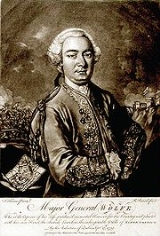
James Wolfe
Overview
Major General James P. Wolfe (2 January 1727 – 13 September 1759) was a British Army
officer, known for his training reforms but remembered chiefly for his victory over the French in Canada
. The son of a distinguished general, Lieutenant-General Edward Wolfe, he had received his first commission at a young age and saw extensive service in Europe where he fought during the War of the Austrian Succession
. His service in Flanders
and in Scotland
, where he took part in the suppression of the Jacobite Rebellion, brought him to the attention of his superiors.
British Army
The British Army is the land warfare branch of Her Majesty's Armed Forces in the United Kingdom. It came into being with the unification of the Kingdom of England and Scotland into the Kingdom of Great Britain in 1707. The new British Army incorporated Regiments that had already existed in England...
officer, known for his training reforms but remembered chiefly for his victory over the French in Canada
Canada, New France
Canada was the name of the French colony that once stretched along the St. Lawrence River; the other colonies of New France were Acadia, Louisiana and Newfoundland. Canada, the most developed colony of New France, was divided into three districts, each with its own government: Quebec,...
. The son of a distinguished general, Lieutenant-General Edward Wolfe, he had received his first commission at a young age and saw extensive service in Europe where he fought during the War of the Austrian Succession
War of the Austrian Succession
The War of the Austrian Succession – including King George's War in North America, the Anglo-Spanish War of Jenkins' Ear, and two of the three Silesian wars – involved most of the powers of Europe over the question of Maria Theresa's succession to the realms of the House of Habsburg.The...
. His service in Flanders
Flanders
Flanders is the community of the Flemings but also one of the institutions in Belgium, and a geographical region located in parts of present-day Belgium, France and the Netherlands. "Flanders" can also refer to the northern part of Belgium that contains Brussels, Bruges, Ghent and Antwerp...
and in Scotland
Scotland
Scotland is a country that is part of the United Kingdom. Occupying the northern third of the island of Great Britain, it shares a border with England to the south and is bounded by the North Sea to the east, the Atlantic Ocean to the north and west, and the North Channel and Irish Sea to the...
, where he took part in the suppression of the Jacobite Rebellion, brought him to the attention of his superiors.
Unanswered Questions

